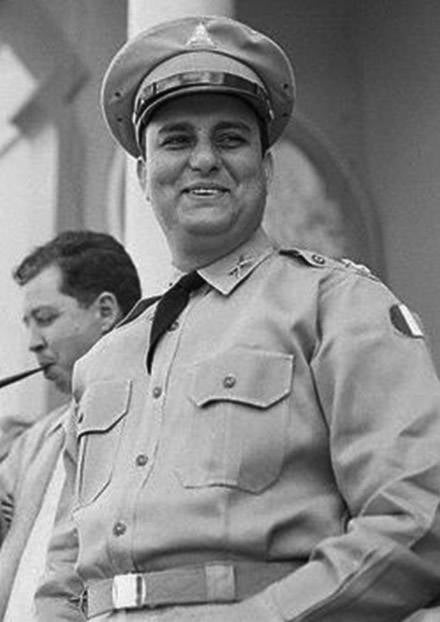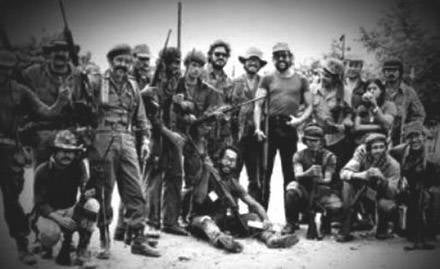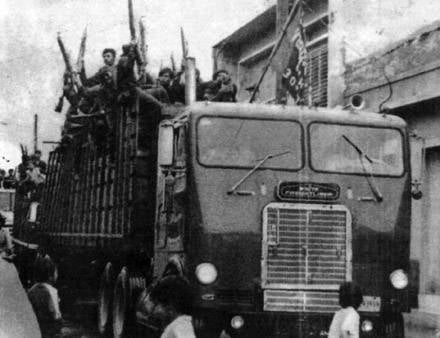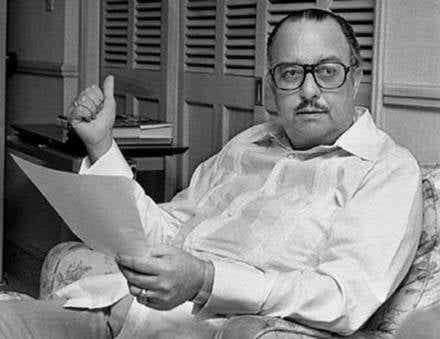Kill "Reptile"

Anastasio Somoza Debile, nicknamed by his father “Tachito” (diminutive from Tacho - short for Anastasio), was the third child of Anastasio Samos Garcia (President of Nicaragua) and Salvador Debile. At the age of ten, Tachito was sent to study in the United States. He and his older brother Luis Somoza Debile studied at St. Leo Preparatory College in Florida and at La Salle Military Academy in Long Island. After completing his studies, he passed the entrance exam and on July 3 of the year 1943 was enrolled in West Point Military Academy cadet, which trains US military officers. 6 June 1946, he graduated it. After returning, Tachito was appointed chief of staff of the National Guard, which, in fact, was the national army of Nicaragua. He was appointed to this post by his father, who distributed high positions to his relatives and personal friends. As head of the National Guard, Somoza led the armed forces of Nicaragua and became the second person in the country for influence. At the end of 1950, he married his cousin Hope Portocarrero, who was a US citizen at the time of the wedding. Subsequently, they had five children.
Rule Brothers
After killing 21's father in September 1956, older brother Louis took on the role of president. As before, the brothers continued pro-American and anti-communist policies.
Together with his elder brother Louis (Nicaraguan president from 1956 to 1967), Anastasio ardently supported the overthrow of the pro-communist government of Jacobo Arbens Guzmán in Guatemala, organized by the United States. Also, the Somoza dynasty for a long time provided comprehensive diplomatic support at the UN to the Chinese nationalist Chiang Kai-shek in his struggle against communist China.
In preparation for the invasion of Cuba by a group of anti-communists who, at the beginning of the 1960s, with the support of the United States, overthrew the government of Fidel Castro, the Somoza brothers provided them with a military base in Puerto Cabezas. It was from there that the 2506 Brigade, formed by the anti-communists, in 1961, set off to liberate Cuba from castors. This support led Fidel Castro to declare both relatives his personal enemies and later actively helped the Marxist rebels from the Sandinista National Liberation Front with money, information, weaponsand also assisted them in training.
Distinguished Anastasio and fiery support of the beast-like anti-communist regimes Duvalier in Haiti, Mendez Montenegro and Ariana Osorio in Guatemala.
Dictator
Shortly after the death of his elder brother 1 in May 1967, Anastasio Somoza elected himself to the presidency of Nicaragua for the first time. It should be noted that the reign of Louis was softer than under their father, but Anastasio was intolerant of any kind of opposition, and therefore his regime began to tighten immediately.
A. Somoza continued to rule the country, relying on US military and economic assistance, the aristocracy and the well-armed and trained 12-thousand guards, whose officer corps was a closed and privileged caste.
His term was to end in May 1972, and the law prohibited immediate re-election. However, before the end of his term in office, Somoza worked out an agreement that allowed him to run for election in the 1974 year. Until that time, a three-person junta was to replace him as president: two liberals and one conservative. At the same time, Tacho retained control of the national guard. Anastasio Somoza and his triumvirate created a new constitution, which was ratified by the triumvirate and the 3 cabinet on April 1971. Having solved this task, ensuring his return to the presidency, 1 May 1972, he resigned as president. However, remaining at the head of the National Guard, he was the de facto ruler of the country.
"Effective control" Anastasio Somoza
December 23 The 1972 earthquake struck Managua, which virtually destroyed the capital of the country. As a result, about 5000 people died. Martial law was declared, which in fact once again made Somoza the ruler of the country. As head of the national emergency committee, he assumed the task of effectively monitoring the situation of rebuilding the city. In fact, it is known about the appropriation of enormous funds allocated from different countries for the restoration of Managua. As a result of this "effective control", some areas of Managua have not been restored, some objects are still being restored, including the national cathedral. At a time when there was a shortage of necessary medications, including blood for transfusions, Somoza sold Nicaraguan blood plasma abroad to assist the victims.
However, in the 1974 election of the year, Somoza was re-elected president.
Beginning of the End
However, by this time the Catholic Church began to oppose the policies pursued by the president. One of his most vehement critics was Ernesto Cardenal, a Nicaraguan priest of the left, who preached the ideology of liberation and later became minister of culture in the Sandinist government. By the end of 1970, groups of human rights activists began to criticize laws issued by the Somoza government. At the same time, support for the Sandinista struggle grew inside and outside the country.

Aware of the threat that came from the Sandinistas, Somoza launched an active campaign in 1975 to suppress this popular front and everyone who supported him.
The front got its name in honor of Nicaragua’s rebel leader in the 1920s. This front began its rebel struggle against the regime of the clan Somoza in 1963, with the financial support of the USSR and Cuba. The Sandinista National Liberation Front (SFNO), whose units were divided and armed with rifles from the First World War, did not pose a significant threat to the regime until 1976. However, in the second half of the 1970 of the last century, a turning point occurred. Support for the Sandinistas has increased markedly since the Managua earthquake and the revealed abuses of the Nicaraguan government. At this point, not only the Sandinistas, but also other prominent political figures were in the ranks of the opposition. However, the political opponents of the dictator were subjected to sophisticated torture and executions — quartered, garrote, and torn to pieces by wild beasts.
As a result, on January 10, 1978, after the murder by the guardsmen of the editor-in-chief of the opposition newspaper La Prensa, Pedro Joaquin Chomorrah, an armed uprising began in the country.
Loss of allies and strengthening of enemies
The massive impoverishment of an already poor country made the population take up arms.
The time has come for the Castro brothers to repay the Somoz clan with the same coin. Partizan began to openly support Cuba, which sent military advisers to Nicaragua. On the side of the rebels stood the Catholic Church. Finally, a fatal change occurred in Washington for Somoza. Presidential Administration Carter, proclaiming the fight for human rights around the world as a priority for its policy, could no longer support Somoza, who brought the number of homeless people in Nicaragua to 600 thousand (with a population of 3,5 million), the number of victims of the civil war to 50 thousand, and foreign debt - Up to 1,6 billion dollars.
International sanctions were applied to Nicaragua, and as a result, the only country that continued to supply weapons to the Somoza regime was Israel. Such friendship had long roots - in 1948, Father Tacho rendered serious financial support to newly created and belligerent Israel. However, Jimmy Carter used all his influence and forced the Israelis to recall the ship carrying the weapon that was vital for the survival of the Somoza regime.
Somoza begged Carter for help. Vice-President of Nicaragua, Luis Pallais, delivered a speech in the US Congress in which he prophesied: “You still curse the day when you did not have enough determination to stop the expansion of Soviet imperialism on the continent,” but did not convince anyone. At the end of June, the Pentagon's 1979, by virtue of a perennial habit, put the 82 Airborne Division into a state of increased combat readiness, but the matter ended. Leading US media have started talking about the “complete collapse of US Central American politics” and even about “a lost battle that will lead to a defeat in the global confrontation between the USA and the USSR.”
Exile
Understanding that the denouement is close, many members of the Somoza family fled the country to Honduras, Guatemala and the United States. The places of their residence are still unknown, since they changed their names to save themselves from the revenge of the rebels. Understanding the obviousness of the fall of his regime, A. Somoza ordered at dawn 17 on July 1979, to dig out the coffins from the earth with the bodies of his father and older brother, as well as all the departed family members who had ruled Nicaragua for 42 years. The coffins, as well as bags of cash and jewels (the dictator’s personal fortune was estimated at 400 million dollars) filled the cargo hold of the converted private aircraft. The passenger compartment was filled with his relatives, comrades and senior officers of the National Guard. Having instructed Colonel Frederico Mahia to perform his duties, the dictator fled to the United States. However, Colonel Mahia immediately disappeared, and his officers fled, leaving the National Guard soldiers to their fate.

First, Somoza arrived in Florida, from where he later moved to the Bahamas, hoping that he could still return to Nicaragua, because then American Ambassador Lawrence Pezzulo said that his return to his homeland was the matter of the next six months. Petstsulo said that after the new civilian government came to power, the people would calm down and the United States would be able to agree with the new regime on the return of the dictator. However, no negotiations followed. The former president closely followed the events that took place in the new Nicaragua. A year after his escape, he published a book, The Devotee of Nicaragua, in which he spoke in detail about the collapse of his regime and the betrayal of Washington.
Nevertheless, Somoza did not give up. He decided to uncompromisingly fight the Communists from his refuge in Paraguay. With the help of the Stroessner regime officials, General Somoza managed to settle in one of the most prestigious areas of the capital - on General Francisco Franco Avenue.
Having a considerable amount of money in his accounts, he was going to spend it on financing the counter-revolutionary forces, which were a great danger to the new government. At the same time, he quickly moved from words to deeds. Thus, two months before the assassination, Anastasio Somoza sent over a million dollars to Honduras in order to finance the creation of the first counterrevolutionary group, “The Democratic Power of Nicaragua” (Fuerza Democrática Nicaraguense - FDN), which was mostly made up of former National Guard fighters who hid in this country. Somoza cheered up - he really believed that the day would come and he would return home as a winner.
However, his dreams did not come true. Somoza was killed near his home on September 17 of 1980 as a result of the assassination attempt, which was organized by the Sandinist commando group of the Argentine terrorist group “People’s Revolutionary Army”.
"People's Revolutionary Army"
The victorious Sandinist guerrilla army largely consisted of Marxists from various Latin American countries who were inspired by the first success of their like-minded people in Cuba in 1959.
One of them was Gorriaran Merlot, who led the "Revolutionary Army", which consisted of several dozen Argentines and foreigners who tried to use the victory of the Sandinistas for their own purposes.
"People's Revolutionary Army" fought against the regular troops of Argentina for more than seven years. But by 1977, this partisan formation was completely crushed, and the remaining cadres fled to the north of Brazil, and then to Europe.
“As a military organization, we were destroyed and, settling in Europe, only aggravated our position,” said one of the fighters. - The main part believed that the “Revolutionary Army” could never be reborn if it continued to sit on its ass in Europe. We needed to return to Latin America. ” For Gorriaran Merlot and the rest of the militants who adhered to a hard line, the Sandinistas revolution was the message of God.
That is why, a few weeks before the Sandinista triumph, the expeditionary forces of the “People’s Revolutionary Army” joined the forces of the Sandinist partisans under the command of Eden Pastor in Costa Rica. The People’s Revolutionary Army Group, led by members of the Junta Revolutionary Coordination, Hugo Irūrsun (captain of Santiago) and Enrique Gorriaran Merlot (Comandante Ramon), consisted of about fifty Argentine militants who took part in the latest "strategic offensive" FSLN as part of the "International Column" of the Southern Front.
“We want to do this in solidarity!”
After the war, the contingent of the “Revolutionary Army” adhered to the line of the Sandinista commandant Thomas Borghe, who became in Nicaragua a new minister of internal affairs. Gorriaran initially began working in the Sandinist state security structure, but a month later he left there in order to open the “Revolutionary Army” office in Managua and begin work on the restoration of the organization.
Hugo Irurzun (pseudonym "Santiago") and Osvaldo Farfan (pseudonym "Roberto Sanchez" or "El Gordo" (Fat Man). Irurzun worked in state security bodies. Farfan worked in the Nicaraguan police.
In the early months of the Sandinista government, the Borg rejected a huge number of proposals to kill Somoza. But he explained to all applicants that Somoza is more useful alive than dead, because he is a gorilla that scares people.
One of the conspirators from the Revolutionary Army told Borg that he wanted to kill Somoza in solidarity. However, he again received a categorical refusal.
But the terrorists did not agree with this position of the Sandinista, since all members of the group were radically inclined people. They considered Somoza a murderer and an enemy of his people. Therefore, they were convinced, the overthrown dictator must be killed.
According to another version, the assassination plan was approved by the directory of the Sandinista National Liberation Front, which allocated a considerable amount of money for organizing the execution (in different sources, the amount varies from 60 to 80 thousand dollars) for the operation in Paraguay.
Anyway, the operation, which received the conditional name “Reptile”, was financed by someone. Argentine terrorists simply did not have the means to carry it out.
Teaching terrorist team in Colombia
15 January 1979 of the year on a rented farm, located two hours away from Bogota (Colombia), began the training of a team of militants elected to carry out the action.
Military courses included training in shooting from a wide variety of weapons and training in reconnaissance and counterintelligence techniques, which were tested in practice in the capital of Colombia. In addition, militants studied karate and practiced weightlifting.
Classes took 8 hours a day, six days a week. The courses continued for more than three months, during which the team was finally approved, which was assigned to execute the murder of the former dictator.
In Paraguay. Preparation for surgery
In March 1980, seven Argentines (four men and three women) arrived in Asuncion by plane from Brazil. With the help of intelligence methods, the urban zone was determined, and then the house itself, where Somoza lived.

I must say that Somoza lived a quiet life, relaxing in a villa located on Avenida Asuncion. Since he did not hide from anyone, his habitat was quite easy to find. It was much harder to figure out how to kill him. The terrorists followed him everywhere for several days. Observations showed that he did not work anywhere, but none of his days was similar to another. There was no ordinary routine when one could calculate the time and place of his appearance. Nevertheless, the militants continued a detailed study of the life of the future victim, and as a result, Somoza’s characteristic routes, the schedule of his day, the guard’s location, etc. were finally established. After a while, one of the Argentines named Osvaldo managed to get a job in a bribe 150 meters from the house of the ex-dictator kiosk, and now the observation has become almost continuous: absolute visual control was established over the object. The fighters even managed one night to “lead” Somosa to a luxurious restaurant, where he went to spend time in the company of his new girlfriend, Dinora Sampson.
As a result, the partisans developed 14 of various plans, including a raid on the house of the former dictator. But the best option was an ambush on one of the city streets. In the end, during the observation, it was established that whenever Somoza left the house, he was driving along the avenue and was not trying to change his route here.
Somoza often drove around the city in a Mercedes-Benz car, which was supposed to be armored in the front. In this case, when the frontal shot from the RPG on the car, inclined armor plate could cause the grenade to go up ricochets. Therefore, we decided to take a side position for an ambush in order to exclude any deviations of grenades.
In July, one of the militants went to Argentina to transport weapons to Paraguay to carry out the operation: a FAL rifle, two Browning 9-mm pistols, explosives, detonators and grenades. In addition, the conspirators probably obtained a Soviet-made RPG-2 anti-tank grenade launcher, two Ingram machine-guns with silencers and two M-16 rifles from Nicaragua.
According to another version, the group of terrorists was armed with two Soviet-made machine guns, two AK-47 assault rifles, two automatic pistols and an RPG-7 anti-tank rocket launcher with ammunition of four anti-tank grenades.
All weapons were moved from Posadas (Argentina) to Encarnacion (Paraguay) by land smuggling under the guise of spare parts. In Asuncion, it was hidden in the hiding places located in the houses where the militants lived.
Last preparations
28 August, an attractive blonde from Argentina under the name Alejandra Renata Adler rented an empty two-story house with a balcony just four blocks down the alley from the Somoza mansion on General Francisco Franco Avenue. The house was owned by a native of Chile. Alejandra Adler told her that she represents Spanish singer Julio Iglesias, who was privately planning to make a film in Asuncion. Hearing about this, the owner of the house was delighted: “This is wonderful! My house will be famous! ”
Suddenly, Somoza disappeared from the sight of the terrorists. Finally, 15 September 1980, after several days of uncertainty, Somoza reappeared in his home. Immediately after his return, a general meeting was held, at which the militants decided to proceed to the direct execution of the armed action.
Having prepared a truck and two cars, weapons, fake passports and portable radio stations, the group prepared for the assassination attempt, planning it the next day. In the end, the partisans developed a plan in accordance with which three were to carry it out: Gorriaran, Irurzun and Farfan.
Attempt on "Reptile"
On Wednesday, 17 September 1980, around 10 in the morning, an observer who worked under the visible seller of magazines and newspapers in the kiosk, which was located across the street from Somoza’s house, told Gorriaran by radio that the object had left his house. At this time, Farfan was waiting for the wheel of a blue Chevrolet pickup, which parked in a side street nearby. When Somoza's limousine was almost passing the lane, a pickup truck jumped out into the street in front of it, forcing the white Mercedes to stop. According to another version, Farfan deliberately collided with some kind of car and thus occupied the roadway, which caused the ex-dictator's car to stop.
At this time, Irurzun stood on the balcony with a grenade launcher. He should have been the first to fire on Somoza’s car, but the grenade launcher snapped. The bodyguards of Somoza, who were riding in a red van, had already jumped out into the street with their weapons at the ready. Gorriaran, who was standing in the courtyard, understood that he needed to do something, and made the only right decision - to open fire on the car with a rifle. He planted the entire clip with his M-16 into the right rear door, where Somoza sat. To his surprise, he saw that the bullets were stitching the door and smashing the window. This was surprising, since the terrorists were confident that the car was armored.
Gorriaran fired the entire magazine on target, after which he reloaded the rifle and opened fire on the bodyguards who had an exchange of fire with Farfan sitting in the truck. At this time there was a sharp sound that cut the air, and an RPG grenade, released by Irurzun, crashed into the roof of a Mercedes. The explosion blew off the roof of the sedan. A third grenade exploded outside. After that, Irurzun rushed down the stairs and joined the Gorriaran, after which both of them ran to the blue truck and jumped into it. Farfan started the engine, and the car, rushing from a place, rushed off.
As a result of the ambush, three people were killed, the burned bodies of which were found in the car. Somoza died after receiving 25 bullet wounds. His body was so disfigured that only his legs could identify him. Also in the car killed the new driver of the ex-dictator and his personal financier.
Of the seven terrorists, six managed to safely escape from the scene of the attack and leave the country. Only Irurzun, who regretted the dollars remaining in the 7000 house, returned for them the next day, where he was identified by a noticeable blond beard by local residents. As a result, he died in unclear circumstances after being captured by the police.
It was his police who presented the press as the leader of a terrorist group. The Paraguayan police never publicly acknowledged that Gorriaran Merlot was at that time in the country. However, she managed to establish who was hiding under the name Alejandra Adler. It was the Argentine revolutionary, the militant Silvia Mercedes Hodgers. Soon, she held a press conference in Mexico, confirming her role in this operation and providing some details. Other participants in the assassination attempt, having left Paraguay without hindrance, returned to Nicaragua.
Gorriaran reported that his commandos carried out "revolutionary justice" against Somoza in order to atone for "national disgrace."
As a result, a number of conclusions can be drawn. Many, if not all, of the assassination at one time or another worked as agents of state security of the Sandinista Ministry of the Interior or as police officers.
The destruction was planned, planned and executed by the Argentine People’s Revolutionary Army. Somoza was killed despite objections from the Sandinista government of Nicaragua.
Somoza was buried in Miami. His funeral was a pretext for the organization in Florida of protest speeches by wealthy immigrants from Nicaragua and Cuba against the Sandinista government of Nicaragua and the Castro regime in Cuba. However, it turned out that the group of protesters consisted of the former Somoza National Guards, who formed the Contra squad to fight the Sandinista government. With their performances they tried to attract public opinion and justify their military operations.
With the destruction of Anastasio Somoza, the financing of the Contra detachments finally stopped. His son, Anastasio Somoza Portocarrero, went into exile in Guatemala and did not take part in the political struggle.
Information